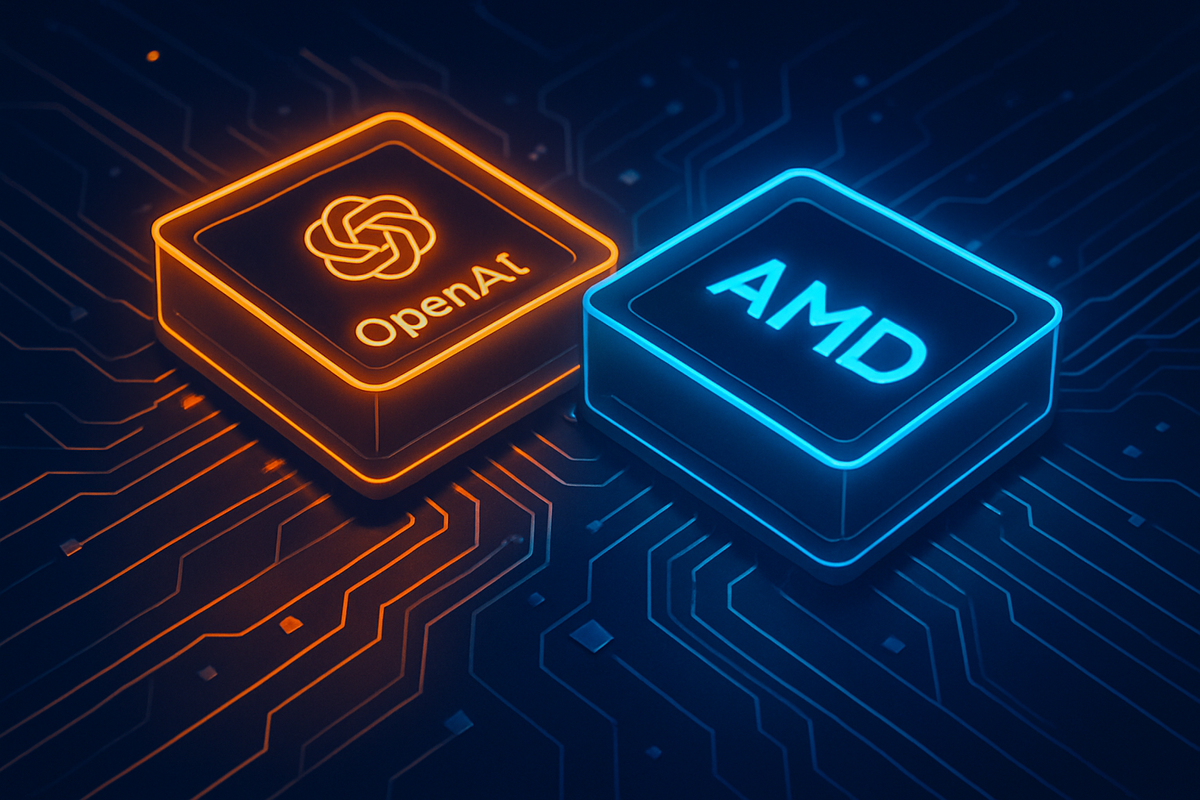
San Francisco, CA – In a landmark announcement that sent ripples across the global technology and financial markets, OpenAI and Advanced Micro Devices (AMD) (NASDAQ: AMD) have forged a multi-billion dollar strategic partnership. Revealed on October 6, 2025, this colossal deal is set to reshape the landscape of AI hardware dominance, challenging established players and signaling a new era of diversification in the supply of critical AI infrastructure.
The agreement, focusing on the supply of AMD's cutting-edge AI chips for OpenAI's next-generation artificial intelligence infrastructure, is a testament to the insatiable demand for computing power driving the AI revolution. It not only provides OpenAI with a robust and diversified source of GPUs but also catapults AMD into a more formidable competitive position against its rivals in the burgeoning AI chip sector. The implications for the broader tech commodity market are immediate, pointing towards intensified competition, strategic alliances, and potential shifts in market valuations.
Unpacking the Landmark Alliance: Details, Timeline, and Initial Reactions
The strategic partnership between OpenAI and AMD is a multi-year, multi-generational agreement designed to significantly bolster OpenAI's computing capabilities. Under the terms of the deal, OpenAI has committed to deploying a staggering 6 gigawatts of AMD's advanced Instinct Graphics Processing Units (GPUs). This monumental rollout is slated to commence with an initial 1-gigawatt deployment of AMD's forthcoming MI450 series chips in the second half of 2026, a capacity roughly equivalent to the energy needs of five million U.S. households.
A particularly noteworthy aspect of the agreement grants OpenAI the option to acquire up to a 10% stake in AMD. This equity alignment will be facilitated through a warrant for up to 160 million AMD common shares at a nominal price of one cent per share. The vesting of these shares is performance-based, contingent upon OpenAI achieving specific deployment milestones for the chips and AMD meeting certain share-price targets. Financially, AMD anticipates this deal will generate tens of billions of dollars in annual revenue, with projections soaring to over $100 billion in new revenue over four years, driven not only by OpenAI but also by an expected ripple effect on other customers. The collaboration extends beyond mere procurement, encompassing a deep technical exchange aimed at optimizing hardware and software roadmaps across multiple generations of AMD Instinct GPUs, building upon previous work with the MI300X and MI350X series.
The official announcement on October 6, 2025, followed months of speculation and underscores a strategic move by OpenAI to diversify its chip supply chain. While OpenAI maintains a separate, substantial $100 billion partnership with NVIDIA (NASDAQ: NVDA) for 10 gigawatts of computing power, this AMD deal signifies a clear intent to mitigate reliance on a single supplier and foster competition. Initial market reactions were swift and decisive. AMD's shares surged dramatically by over 30% post-announcement, adding approximately $80 billion to its market capitalization. Conversely, NVIDIA's stock experienced a slight decline, reflecting investor recognition of increased competition, although analysts largely agree the deal is more a reflection of the enormous, unmet demand for AI computing rather than a direct threat to NVIDIA's existing market share.
Reshaping the AI Arena: Winners, Losers, and Market Impacts
The immediate and most significant winner from this partnership is undoubtedly Advanced Micro Devices (AMD). This deal provides substantial validation of AMD's Instinct AI chips and its accompanying software ecosystem, positioning the company as a pivotal strategic partner in the rapidly expanding AI infrastructure market. The guaranteed revenue stream, projected to be in the tens of billions annually, will fuel AMD's research and development, enabling it to accelerate its roadmap and compete more aggressively. The equity stake option for OpenAI also fosters a deeper, symbiotic relationship, potentially influencing future chip design to better suit OpenAI's evolving needs. This move solidifies AMD's position as a credible institutional "second source" for frontier AI chips, a crucial development for an industry previously dominated by a single player.
On the other side of the coin, NVIDIA (NASDAQ: NVDA), while still the undisputed market leader, faces a new competitive dynamic. While analysts suggest the sheer demand for AI chips means there's ample room for multiple players, the OpenAI-AMD deal signals a clear strategic effort by major AI developers to diversify their supply chains. This could lead to a moderation of NVIDIA's pricing power in the long run and necessitate accelerated innovation to maintain its competitive edge. Other potential losers could include smaller AI hardware startups struggling to gain traction, as major players consolidate their supply lines with established giants. However, the overall boom in AI infrastructure could also create opportunities for companies providing ancillary services, cooling solutions, and specialized data center components.
The broader semiconductor market will also experience significant shifts. Companies involved in the manufacturing process, such as Taiwan Semiconductor Manufacturing Company (TSMC) (NYSE: TSM), which fabricates AMD's advanced chips, could see increased demand. However, this also raises questions about potential manufacturing bottlenecks if demand continues to outpace production capabilities across the industry. The deal also highlights a growing trend where AI developers are not just customers but active co-investors in their hardware suppliers, suggesting a new model for financing critical infrastructure that could see more equity-based alignments in the future.
A New Paradigm: Wider Significance and Industry Transformation
This landmark partnership between OpenAI and AMD fits squarely within several broader industry trends, most notably the escalating race for AI hardware dominance and the strategic imperative for supply chain diversification. As AI models become increasingly complex and data-hungry, the demand for specialized, high-performance computing units has exploded. This deal underscores that companies like OpenAI cannot afford to rely on a single supplier, not only for security of supply but also to foster innovation and competitive pricing. It represents a mature stage in the AI industry's development, where infrastructure is as critical as the algorithms themselves.
The ripple effects on competitors and partners are substantial. For NVIDIA, it necessitates a recalibration of strategy, potentially accelerating its own product roadmap and emphasizing its integrated software ecosystem (CUDA) as a key differentiator. For other chip designers and AI hardware startups, the deal serves as both a challenge and a potential inspiration, demonstrating that there is indeed a viable path to compete with the market leader. Cloud providers like Microsoft (NASDAQ: MSFT), Google (NASDAQ: GOOGL), and Amazon (NASDAQ: AMZN) (through AWS) are also deeply invested in their own custom AI chips and will be closely watching how this partnership influences the broader market for off-the-shelf solutions.
From a regulatory perspective, while no immediate implications are apparent, the increasing consolidation of power in AI development and hardware supply could attract scrutiny in the future, particularly concerning market dominance and fair competition. Historically, similar strategic alliances have often led to significant shifts in technological paradigms. Comparisons can be drawn to the early days of the PC industry, where strategic partnerships between software and hardware giants dictated market trajectories. This deal signifies a similar inflection point for the AI industry, moving beyond a single dominant hardware provider towards a more diversified and competitive ecosystem.
The Road Ahead: Short-Term Shifts and Long-Term Trajectories
In the short term, the market will closely monitor the execution of this deal, particularly the initial deployment of AMD's MI450 chips in the second half of 2026. Any delays or performance issues could impact investor confidence and AMD's stock trajectory. Conversely, a smooth rollout and strong performance metrics could further cement AMD's position and potentially accelerate additional commitments from OpenAI and other major AI players. NVIDIA will likely intensify its efforts to secure new large-scale deals and highlight its next-generation offerings to counter the narrative of diversification.
Looking further ahead, the long-term possibilities are transformative. This partnership could catalyze a new wave of innovation in AI chip design, as AMD and OpenAI collaboratively optimize hardware and software. It might also encourage other major AI developers to pursue similar equity-aligned partnerships with hardware manufacturers, fundamentally altering the financing and supply chain models for AI infrastructure. Market opportunities will emerge for companies providing specialized cooling, power solutions, and data center management tailored to the massive scale of these new AI superclusters. Challenges include potential supply chain bottlenecks, particularly in advanced packaging and manufacturing capacity, which could constrain the rapid expansion of AI infrastructure.
Potential scenarios range from a robust, competitive duopoly between AMD and NVIDIA in the AI chip market to a more fragmented landscape with other players gaining traction. The outcome will largely depend on the performance and scalability of AMD's future Instinct chips, the continued innovation from NVIDIA, and the evolving needs of AI models. This deal marks a significant strategic pivot for OpenAI, securing its future compute needs while also playing a direct role in shaping the hardware ecosystem.
A New Chapter in AI: Key Takeaways and Future Watchpoints
The OpenAI-AMD chip deal is a watershed moment, signaling a new chapter in the race for AI hardware dominance. The key takeaway is clear: diversification of critical AI infrastructure is now a strategic imperative for leading AI developers. This multi-billion dollar partnership not only validates AMD's growing prowess in the AI chip market but also fundamentally alters the competitive landscape, challenging NVIDIA's long-held near-monopoly. It underscores the insatiable demand for computing power that continues to drive innovation and investment in the artificial intelligence sector.
Moving forward, the market will be keenly assessing several factors. Investors should watch for AMD's progress in scaling production and delivering on its commitments, particularly with the MI450 series. The performance benchmarks of these chips in real-world AI workloads will be crucial. Simultaneously, NVIDIA's response, including its own next-generation chip announcements and strategic partnerships, will be vital to observe. The broader implications for the semiconductor supply chain, especially concerning TSMC's capacity and the development of alternative manufacturing capabilities, will also be a critical watch point.
This event signifies a strategic recalibration for the entire AI industry. It’s a testament to the immense capital and technological resources being poured into building the foundational infrastructure for artificial general intelligence. The lasting impact will likely be a more diversified, competitive, and innovative AI hardware market, ultimately benefiting the advancement of AI itself. The coming months will provide crucial insights into how this landmark deal reshapes the fortunes of technology giants and accelerates the future of artificial intelligence.
This content is intended for informational purposes only and is not financial advice.





